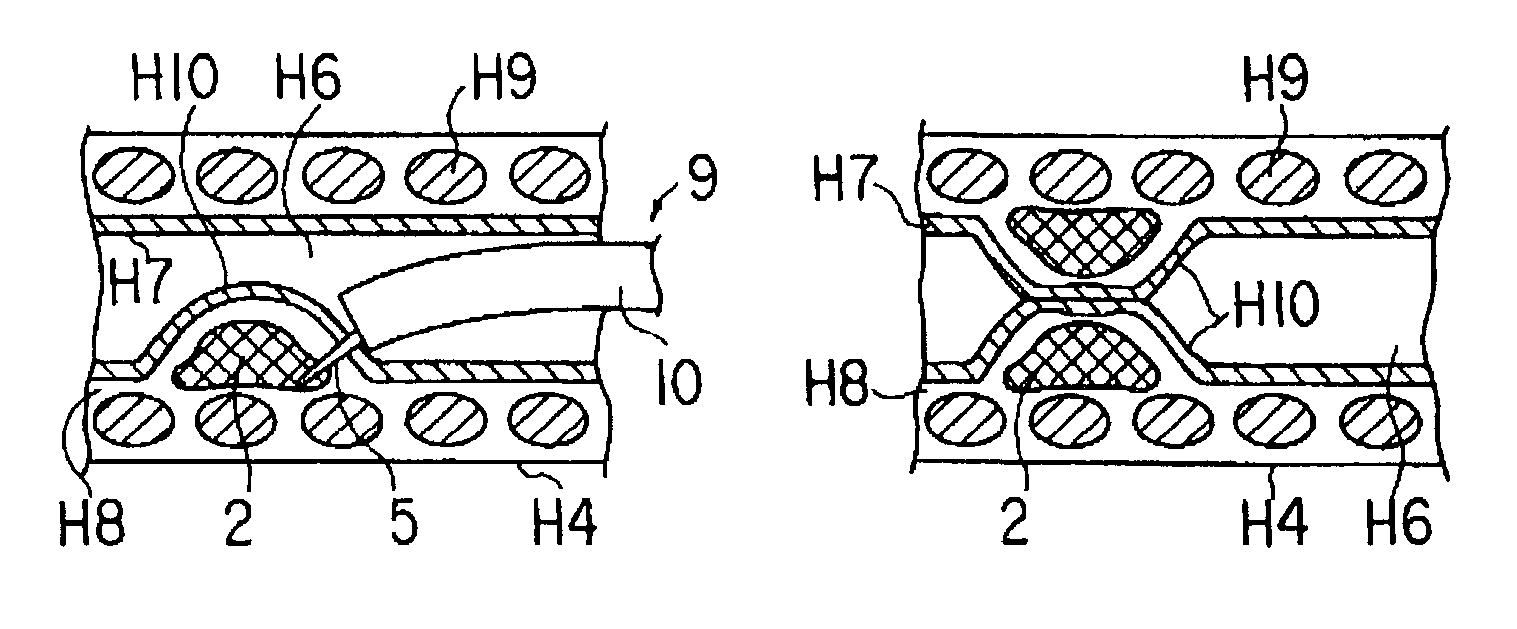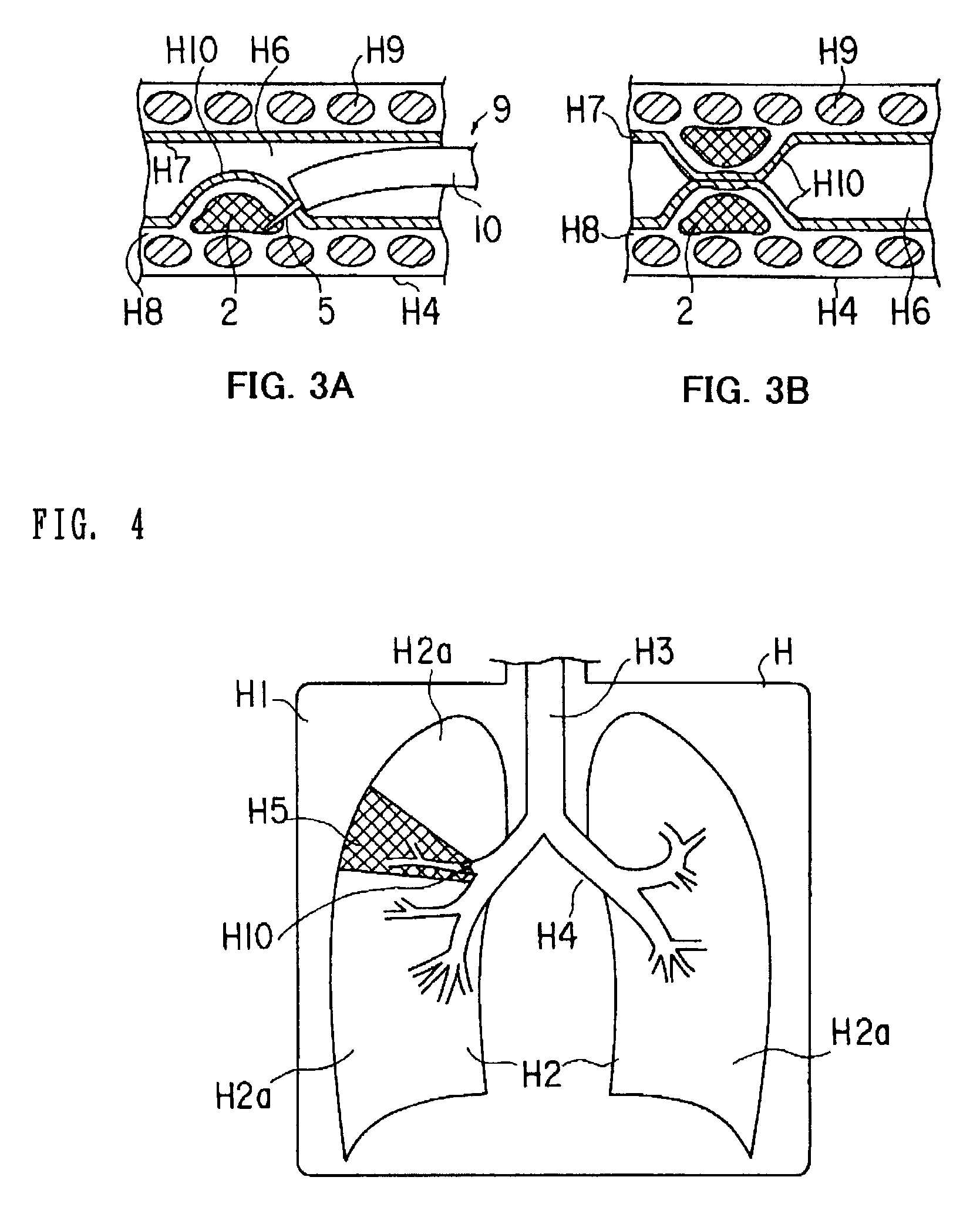Medical device and method of embolizing bronchus or bronchiole
a technology of bronchus and bronchiole, which is applied in the field of medical devices and methods of embolishing bronchus or bronchioles, to achieve the effects of facilitating puncturing manipulation, improving workability, and maintaining swelling
- Summary
- Abstract
- Description
- Claims
- Application Information
AI Technical Summary
Benefits of technology
Problems solved by technology
Method used
Image
Examples
first embodiment
[0059]As shown in FIG. 2, during treatment of lung emphysema in a pleural cavity H1 of a patient H, a bronchoscope 9 is used in combination with the bronchus embolization device 1 of the This bronchoscope 9 is provided with an elongated inserting portion 10 to be inserted into the body of the patient H. A manipulation portion 11 is provided in a proximal portion of the inserting portion 10 on the operator side.
[0060]Furthermore, a channel 10c (refer to FIG. 7) through which to insert a treatment element is provided in the interior of the inserting portion 10 of the bronchoscope 9. A leading opening portion of this channel 10c is provided in a leading portion of the inserting portion 10. The manipulation portion 11 on the operator side is provided with a channel port portion 12, which communicates with a proximal portion of the channel 10c. The injection device 3 is to be inserted into the channel 10c of the bronchoscope 9 from the channel port portion 12.
[0061]The operation of the ...
second embodiment
[0069]Namely, the injection material 2 of the second embodiment has a construction in which a particulate substance 22 which is a solid component is suspended in a liquid base material 21 as shown in FIG. 5A. The constituent material of the injection material 2 is made of a material having good biocompatibility, which does not exhibit toxicity nor stimulus to a living tissue when the material is injected into the submucosa H8 of the bronchus H4. The particulate substance 22 contains a solid component of high biocompatibility, such as silicone, metal particles (such as titanium particles), apatite or β-TCP (tricalcium phosphate).
[0070]In the second embodiment, the constituent material of the injection material 2 used in the bronchus embolization device 1 for embolizing the bronchus H4 and giving treatment for lung emphysema has a construction in which the particulate substance 22, which is a solid component, is suspended in the liquid base material 21. Consequently, the second embodi...
sixth embodiment
[0110]The delivery device 83 is provided with a holding element 84 for holding the placing object 82 and an elongated sheath 85 disposed at the outside of the holding element 84. The holding element 84 is provided with a holding portion 87, such as grasper jaws, for holding the placing object 82 at a leading portion of an elongated shaft 86. In addition, a handle 88 for manipulating the holding portion 87 is provided at a proximal portion of the shaft 86. In this delivery device 83, the holding portion 87 at the leading end of the holding element 84 can move into and out of the sheath 85, and can be made to hold and release the placing object 82 by manipulating the handle 88 on the operator side. Incidentally, in the sixth embodiment, the delivery device 83 is constructed to serve also as a retrieving device, which retrieves the placing object 82.
[0111]The operation of the sixth embodiment having the above-described construction will be described below. In the sixth embodiment, as s...
PUM
 Login to View More
Login to View More Abstract
Description
Claims
Application Information
 Login to View More
Login to View More - R&D
- Intellectual Property
- Life Sciences
- Materials
- Tech Scout
- Unparalleled Data Quality
- Higher Quality Content
- 60% Fewer Hallucinations
Browse by: Latest US Patents, China's latest patents, Technical Efficacy Thesaurus, Application Domain, Technology Topic, Popular Technical Reports.
© 2025 PatSnap. All rights reserved.Legal|Privacy policy|Modern Slavery Act Transparency Statement|Sitemap|About US| Contact US: help@patsnap.com



